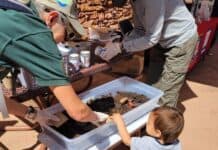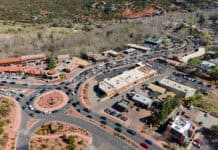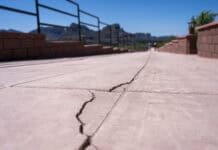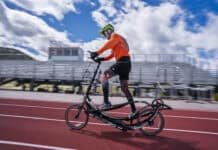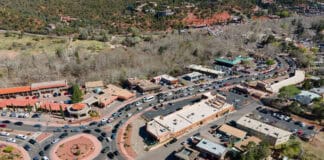Thanks to an eye in the sky, the Sedona Fire District was able to locate an injured mountain biker faster than normal.
On Saturday, March 3, crews responded to a trail near Courthouse Vista off State Route 179 around 1 p.m. They received a report of a mountain biker — who was visiting for the Mountain Bike Festival — who crashed and fell 35 feet down a steep rock face, SFD Fire Marshal Jon Davis said. The biker was left unconscious as a result of the fall, but someone riding with him called 911.
Battalion Chief Dave Cochrane arrived on the scene and chose to deploy the district’s second and newest drone, which was donated two months ago.
“All they had to go on was the general vicinity,” Davis said. “Within two minutes the drone was set up. They found the trail and followed it until they found the mountain biker. They estimated it took about eight minutes before they were able to pinpoint his location.
“A lot of times people are unfamiliar with the area and unsure of where they are. There have been times where they are one to two miles away from where they think they are. There’s no doubt this saved time in finding him.”
Because of the steep terrain, additional crews were called in to perform a highangle rescue. When crews arrived at the mountain biker’s location, Davis said they could not get a good visual on him. So, Cochrane used the drone and its video capabilities to find the safest route to the injured man. It took about three hours before crews were able to bring the man to the trailhead. He was then transported by ambulance to the hospital.
Chief Kris Kazian said that in modern-day fire and rescue operations, using this type of equipment and leveraging technology is the direction the profession is going.
“This illustrates the need to have the necessary tools so we have the ability to quickly locate resources and get definitive care to an injured person,” he said. “The potential future capabilities are endless and we will continue to monitor opportunities to enhance our service with the use of this technology. I’m very proud of our folks for the work and dedication they have to our community.”
A Look Back
In January 2017, Battalion Chief Jayson Coil gave a presentation to the SFD Governing Board about the capabilities of the drone and its necessity. There he showed a short video taken in the Grasshopper Point area simulating how it would be used to find lost or injured hikers. Another portion had it flying along Oak Creek as it surveyed flood damage, stranded vehicles or potential debris floating down. Finally, they flew it over the now-closed Taco Bell/KFC to simulate the best view of a barricade situation, hazardous material spill or structure fire.
In some cases, Coil said it can take the drone less than a minute to get to an area that may take five or more minutes by vehicle.
“It’s a beneficial tool to show potential hazards, especially during floods,” he said last year.
The drone was first put to use on Jan. 6, 2017, when SFD crews assisted those from Copper Canyon Fire District to rescue three individuals who were stranded in their vehicle in the middle of Beaver Creek near Camp Verde. All three of the individuals were pulled to safety. However, it was also used earlier that day during a swiftwater training exercise in Sedona.
“It [the drone] was used to assess the situation upstream for potential hazards to the rescuers and downstream to identify the best location for what we call ‘strong swimmers,’” Coil said the day after the rescue.
Firefighter Marc Howard, who is licensed and certified to fly the drone, and Coil presented the different alternatives to Assistant Chief Jeff Piechura and Kazian. At that time, it was decided they would purchase a lower cost, less robust system and work on assessing merits and limitations, Coil said. The cost of the model being used is $3,200.
The camera, via an app on an iPad, allows operators to view live, high-definition color imaging, as well as record high-definition video, which can be used for future training purposes. It is also capable of taking still photos.
However, the camera does not have a zoom capacity, therefore it must be flown closer to anything that operators want a better view of. The live transmission range is approximately two miles from the control station, while its flying distance is approximately three miles from the operator.
SFD has four batteries for the drone, each of which lasts about 15 minutes while in flight. The aircraft uses GPS to know where it launched from and is supposed to automatically begin returning when the battery gets low.
Ron Eland can be reached at 282-7795 ext. 122, or email reland@larsonnewspapers.com


